
Heartbreak After Gastric Cancer Surgery? The Hidden Link You Need to Know
"Unraveling the mystery of why heart issues can arise post-surgery for gastric cancer and what miR-133a has to do with it."
Gastric cancer, a major health concern worldwide, often requires aggressive treatments like surgery. While these interventions aim to eradicate the cancer, they can sometimes trigger unexpected complications. One of the most serious is acute myocardial infarction (AMI), commonly known as a heart attack.
The link between gastric cancer surgery and subsequent heart issues has puzzled doctors for years. Recent research is shedding light on a key player: a tiny molecule called microRNA-133a (miR-133a). This molecule, it turns out, is abnormally expressed in patients who experience AMI after undergoing surgery for gastric cancer.
This article breaks down the complex science to explain how miR-133a is involved in the damage to blood vessels after surgery, potentially leading to heart problems. Understanding this connection is crucial for improving patient care and outcomes.
What is miR-133a and Why Should You Care?

MicroRNAs (miRNAs) are small, non-coding RNA molecules that regulate gene expression. Think of them as tiny switches that can turn genes on or off. They play critical roles in various biological processes, and when their expression goes awry, it can contribute to diseases, including cardiovascular issues and cancer.
- Increased Endothelial Injury: AMI patients showed higher levels of endothelial injury markers, indicating damage to the blood vessel lining.
- miR-133a Connection: Higher miR-133a levels were also found in these patients, suggesting a link between miR-133a and endothelial injury.
- Animal Studies: Experiments in rats confirmed that manipulating miR-133a levels could worsen or improve endothelial injury.
The Hope for Future Treatments
The study highlights the significant role of miR-133a in the development of AMI following gastric cancer surgery. By understanding how miR-133a contributes to endothelial injury, researchers and clinicians can explore new therapeutic strategies to protect the heart in these vulnerable patients. Further research is needed to determine whether targeting miR-133a can prevent AMI and improve outcomes for individuals undergoing radical surgery for gastric cancer. This could pave the way for more tailored and effective treatments, minimizing the risk of heart complications and enhancing the overall well-being of those affected by gastric cancer.
